NGC 4236 – Barred Spiral Galaxy
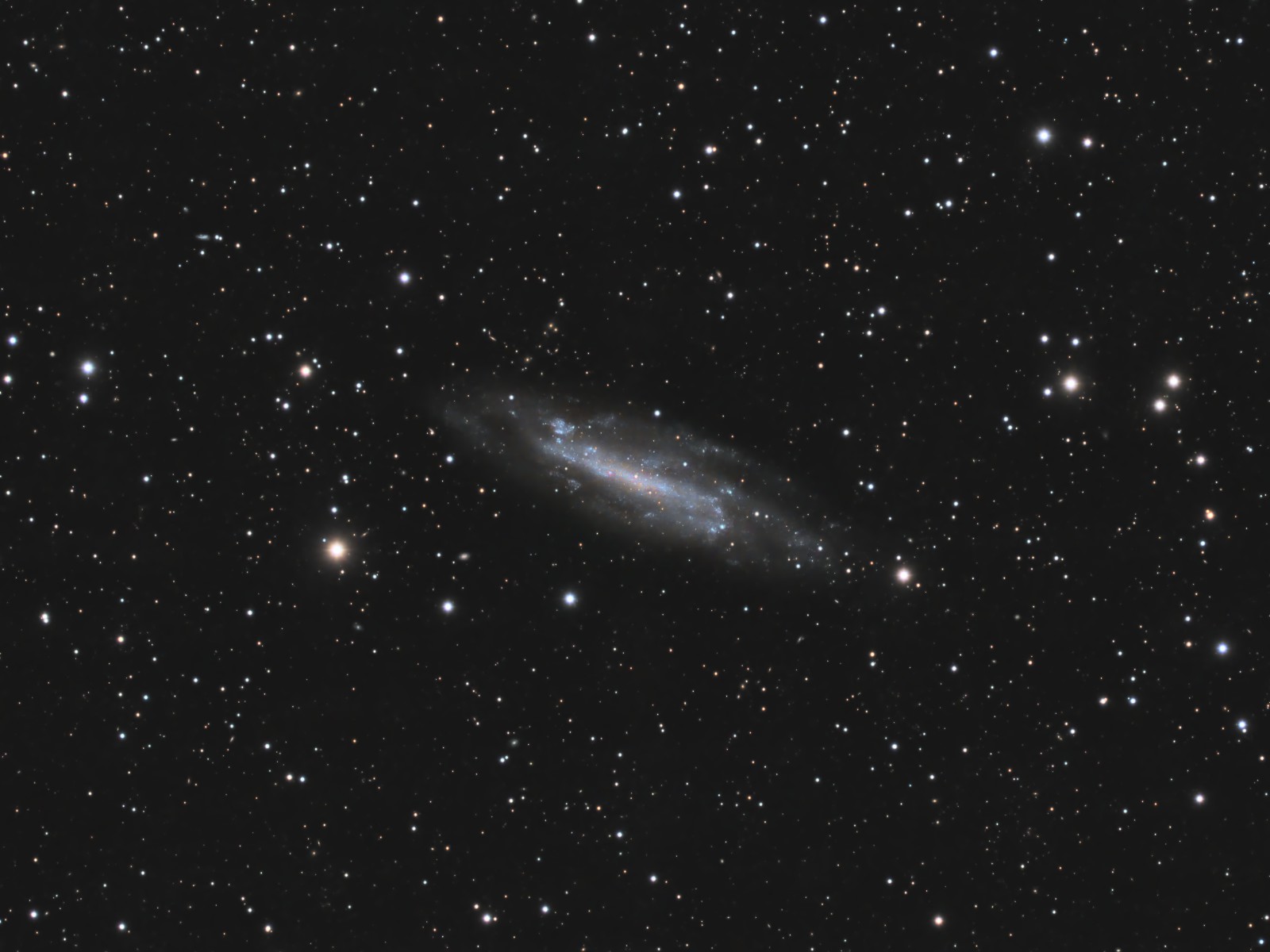 Click image for full size version
Click image for full size version
May 4, 2020
NGC 4236 is a barred spiral galaxy in Draco, the Dragon. It is large (its length is more than 2/3 the Moon’s width) but has a very low surface brightness, meaning it is barely brighter than the background glow of the sky (mean surface brightness is 24.3 mag/asec2; outer arms are much fainter). This makes it quite a difficult object to image. This image shows more than 34 hours of light collected through two telescopes and cameras running simultaneously, as described below. NGC 4236 is part of the M81 group (I have imaged M81 and M82) and lies about 12 million light years away. Some of the many other galaxies in the field are marked on the annotated image, including several in a swarm above the left end of NGC 4236. Click the image to see it full size.
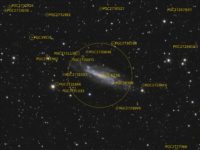 Tekkies:
Tekkies:
Acquisition, focusing, guiding and control of Paramount MX mount with TheSkyX. Focus with Optec DirectSync motor and controller. Automation with CCDCommander. Equipment control with PrimaLuce Labs Eagle 3 Pro computer. All pre-processing and processing in PixInsight. Acquired from my SkyShed in Guelph. No moon, average or better transparency and seeing. Data acquired March 21-April 3, 2020.
Luminance: Sky-Watcher Esprit 150 f/7 refractor and QHY 16200-A camera with Optolong UV/IR filter
Chrominance: Takahashi FSQ-106 ED IV @ f/3.6 and QHY367C one-shot colour camera with Optolong L-Pro filter
Chrominance: 188x 5m = 940m
Total: 34hr20m
Data Reduction and Processing
Preprocessing: The WeightedBatchPreProcessing script was used to create a Luminance master frame (from the mono camera) and a Drizzled RGB master frame (from the one-shot colour camera). MURE Denoise script was applied to L.
Gradient Removal: DBE was applied to L and RGB masters using Subtraction.
Colour
Channel Registration: To improve channel registration, the colour channels of the RGB master were extracted and aligned with StarAlignment, using Thin Plate Splines with Distortion Correction and the green channel as the reference frame. The registered colour channels were recombined with ChannelCombination.
Colour Balancing: Colour was balanced with ColorCalibration.
Linear Noise Reduction: MultiscaleLinearTransform was used to reduce noise in the background areas, using an internal mask to protect bright structures. Layer settings for threshold and strength: Layer 1: 5.0 0.85, 2 iterations; Layer 2: 3.5, 0.75, 2 iterations; Layer 3: 3.0, 0.5, 1 iteration; Layer 4: 1.0, 0.25, 1 iteration.
Stretching: HistogramTransformation was applied to make a pleasing, bright image, with background set to an intensity of approximately 0.10.
Lightness
Deconvolution: StarMask was applied with default settings to produce a Local Deringing Support Image. A clone of the image was stretched with HistogramTransformation and Curves in order to use it as a deconvolution mask. Deconvolution was applied (150 iterations, regularized Richardson-Lucy, external PSF made using PSFImage script with about 50 stars).
Linear Noise Reduction: MultiscaleLinearTransform was used to reduce noise in the background areas, using an internal mask to protect bright stars. Layer settings for threshold and strength: Layer 1: 3.0 0.75, 1 iterations; Layer 2: 2.0, 0.65, 1 iteration.
Stretching: HistogramTransformation was applied to make a pleasing, bright image, with background set to an intensity of approximately 0.10.
Combining Lightness and Colour Images
Registration of L and RGB: StarAlignment was used to register the RGB master to the L master.
LRGB Combination: The lightness image was applied to the RGB image using LRGBCombination with default settings.
Additional Processing
Nonlinear Noise Reduction: TGVDenoise was used in L*a*b* mode to reduce noise with a mask used to target the background areas and protect the stars (max. 1,000 iterations and convergence selected for both lightness and chrominance).
Contrast Enhancement: LocalHistogramEqualization was applied twice using a mask to isolate the core of the galaxy. First pass was Kernel Radius 50, Contrast Limit 1.5 and Amount 0.66. Second pass was Kernel Radius 150, Contrast Limit 1.5 and Amount 0.57.
Sharpening: The galaxy was sharpened with a pass of MultiscaleLinearTransform (bias +0.1 on 2nd and 3rd layers).
Final Steps: Galaxy, background and star brightness, contrast, and colour saturation were adjusted in several iterations using CurvesTransformation with masks as required. ICCProfileTransformation (sRGB IEC61966-2.1; Relative Colorimetric with black point compensation) was applied prior to saving as a jpg.

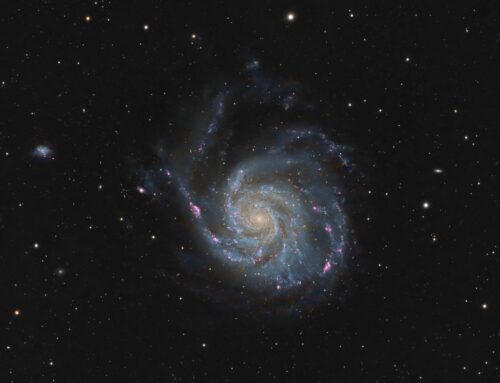
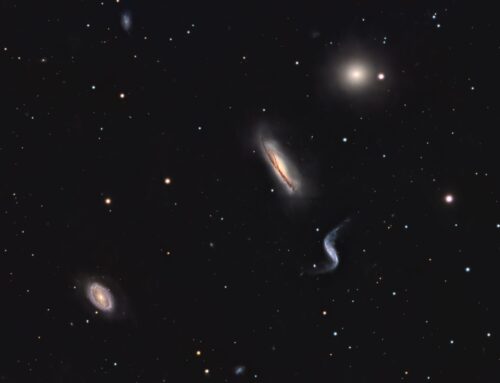
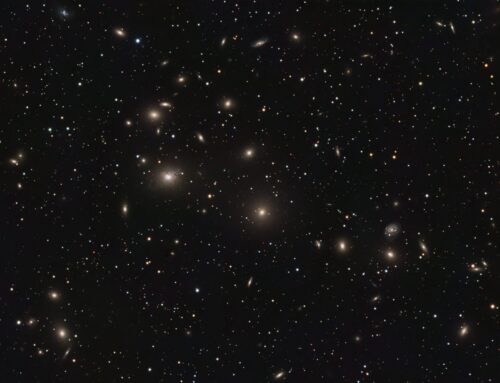
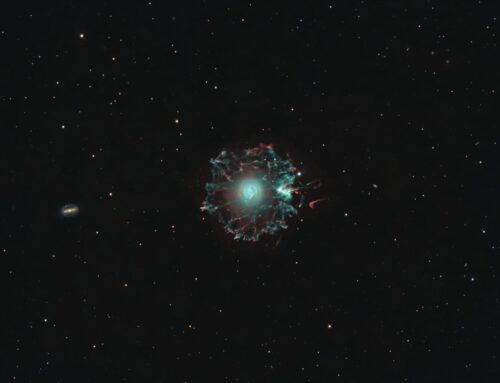
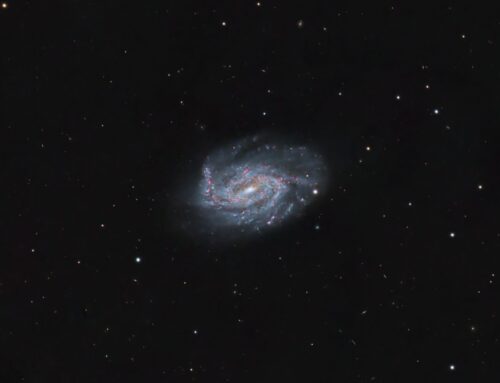
Hi Ron;
The use of separate camera’s and scopes to get the luminance and chrominance details, and then to combine them in PI truely showcases your expertise. Judging by the fine details, this technique is much better than just using OSC data and creating luminance and chrominance.
Yes, it works very well. I’m writing an article for Sky & Telescope about this approach to acquisition.